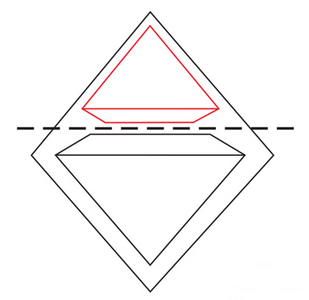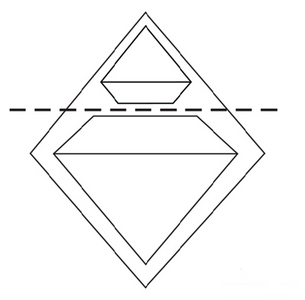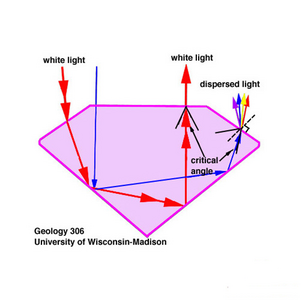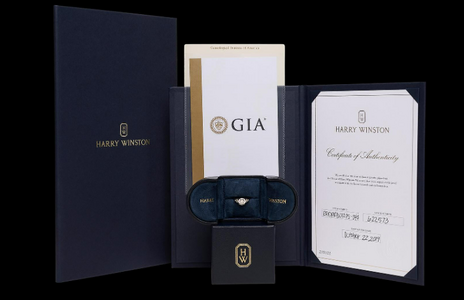- Joined
- Jul 27, 2009
- Messages
- 4,170
60/60 Diamonds
You may have heard the term "60/60" diamonds. If not, you have probably seen some if you have been diamond shopping. These are diamonds with a 60% table and 60% depth percentage, or numbers very close. Diamonds in this proportion range can potentially get the highest cut grade from GIA (Excellent). They can even get an AGS Ideal grade, though much less likely. But there is more to know about 60/60 diamonds to avoid some pitfalls.
There was a time in the not-too-distant past (before overall cut grades were provided on laboratory reports) when “60/60” was a kind of shorthand for a well cut diamond. At the time it was not uncommon for tables to extend to 65% and beyond. Cutting a large table and shallow crown helped manufacturers retain maximum weight from the most common rough – the octahedron. They would saw the stone in two and cut one large stone with a large table/shallow crown and a second stone that would be larger (outlined in red in the illustration below) than if they had put a fuller crown/smaller table on the primary stone. The improved overall yield significantly helped the cutter’s bottom line, even though in most cases the diamonds suffered some light performance deficits.


A large table has the effect of making the crown shallow. Although this can increase spread (outside diameter) it reduces the crown’s ability to gather light and to disperse light into its spectral colors. Thus the diamond tends to be lacking in colored sparkles , otherwise known as “fire”. Marcel Tolkowsky had demonstrated mathematically the benefits of a smaller table and fuller crown decades earlier, but cutting for yield over beauty is a practice that has been slow to die.

A large table reduces the surface area of the crown which is the part of the diamond that gathers light, especially from lower angles. The large table also reduces the size of the crown facets which reduces the size of the virtual facets that we see in the white and colored sparkles that are returned to the eye. And it is the crown facets that fan light out into the different colors of the spectrum after internal reflection and upon exiting the diamond and returning to the eye. A well cut 60/60 diamond can often be very bright with a good quantity of light return, but the quality of that light typically suffers from reduced fire (colored sparkles). A large table can also throw a lot of glare from certain angles, which is technically light return, but it’s not a positive form of light performance.
60/60 Diamonds - Pros and Cons
Increased Yield and Spread
A cutter can improve yield by cutting a primary stone with a flat crown, thereby allowing for a bigger secondary stone. This tends to benefit the manufacturer; not necessarily the consumer.
Bigger tables with shallower crowns, if appropriately proportioned with a precision cut, can deliver outstanding white light return, but at the expense of some fire. As the top gets flatter the diamond performs more like a mirror and less like a prism.
A 60 percent table with a shallow crown and less depth than is typically required by a bigger crown can potentially be “spready”. That is, the weight is spread out over a larger diameter allowing the diamond to be slightly bigger in terms of outer dimensions.
The Trade-off
As the table gets bigger, the surface area of the crown is diminished and crown facets become smaller. Since crown facets are instrumental in producing fire (colored sparkles), a 60/60 will usually not display as much fire as a well cut diamond with a fuller crown.
Diamonds with lower crown heights are not able to tolerate tilt angles as well. The unattractive “fish eye “effect where the girdle reflection is visible at a small degree of tilt is more of a concern in diamonds with larger tables/lower crowns.
The larger table facet will also throw bigger glare from a wider range of viewing angles. Glare will tend to conceal some of the positive aspects of light performance such as fire and scintillation.
To some extent, as the table size increases inclusions become easier to see as the camouflaging crown facets are reduced. Think of an emerald cut with its traditionally large table facet and how revealing it is in terms of clarity features.
Conclusion
60/60 diamonds can be very nice. If cut with precision they can be very bright and spready. But as this proportion set occupies a place at the margins of what can be considered Ideal, it is highly recommended to verify actual performance with ASET and/or IdealScope.
What are your thoughts on 60/60 diamonds? Are they worth the trade-offs?
You may have heard the term "60/60" diamonds. If not, you have probably seen some if you have been diamond shopping. These are diamonds with a 60% table and 60% depth percentage, or numbers very close. Diamonds in this proportion range can potentially get the highest cut grade from GIA (Excellent). They can even get an AGS Ideal grade, though much less likely. But there is more to know about 60/60 diamonds to avoid some pitfalls.
There was a time in the not-too-distant past (before overall cut grades were provided on laboratory reports) when “60/60” was a kind of shorthand for a well cut diamond. At the time it was not uncommon for tables to extend to 65% and beyond. Cutting a large table and shallow crown helped manufacturers retain maximum weight from the most common rough – the octahedron. They would saw the stone in two and cut one large stone with a large table/shallow crown and a second stone that would be larger (outlined in red in the illustration below) than if they had put a fuller crown/smaller table on the primary stone. The improved overall yield significantly helped the cutter’s bottom line, even though in most cases the diamonds suffered some light performance deficits.


A large table has the effect of making the crown shallow. Although this can increase spread (outside diameter) it reduces the crown’s ability to gather light and to disperse light into its spectral colors. Thus the diamond tends to be lacking in colored sparkles , otherwise known as “fire”. Marcel Tolkowsky had demonstrated mathematically the benefits of a smaller table and fuller crown decades earlier, but cutting for yield over beauty is a practice that has been slow to die.

A large table reduces the surface area of the crown which is the part of the diamond that gathers light, especially from lower angles. The large table also reduces the size of the crown facets which reduces the size of the virtual facets that we see in the white and colored sparkles that are returned to the eye. And it is the crown facets that fan light out into the different colors of the spectrum after internal reflection and upon exiting the diamond and returning to the eye. A well cut 60/60 diamond can often be very bright with a good quantity of light return, but the quality of that light typically suffers from reduced fire (colored sparkles). A large table can also throw a lot of glare from certain angles, which is technically light return, but it’s not a positive form of light performance.
60/60 Diamonds - Pros and Cons
Increased Yield and Spread
A cutter can improve yield by cutting a primary stone with a flat crown, thereby allowing for a bigger secondary stone. This tends to benefit the manufacturer; not necessarily the consumer.
Bigger tables with shallower crowns, if appropriately proportioned with a precision cut, can deliver outstanding white light return, but at the expense of some fire. As the top gets flatter the diamond performs more like a mirror and less like a prism.
A 60 percent table with a shallow crown and less depth than is typically required by a bigger crown can potentially be “spready”. That is, the weight is spread out over a larger diameter allowing the diamond to be slightly bigger in terms of outer dimensions.
The Trade-off
As the table gets bigger, the surface area of the crown is diminished and crown facets become smaller. Since crown facets are instrumental in producing fire (colored sparkles), a 60/60 will usually not display as much fire as a well cut diamond with a fuller crown.
Diamonds with lower crown heights are not able to tolerate tilt angles as well. The unattractive “fish eye “effect where the girdle reflection is visible at a small degree of tilt is more of a concern in diamonds with larger tables/lower crowns.
The larger table facet will also throw bigger glare from a wider range of viewing angles. Glare will tend to conceal some of the positive aspects of light performance such as fire and scintillation.
To some extent, as the table size increases inclusions become easier to see as the camouflaging crown facets are reduced. Think of an emerald cut with its traditionally large table facet and how revealing it is in terms of clarity features.
Conclusion
60/60 diamonds can be very nice. If cut with precision they can be very bright and spready. But as this proportion set occupies a place at the margins of what can be considered Ideal, it is highly recommended to verify actual performance with ASET and/or IdealScope.
What are your thoughts on 60/60 diamonds? Are they worth the trade-offs?
Last edited by a moderator:










300x240.png)